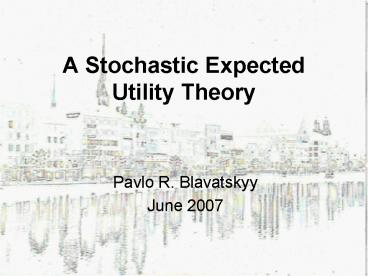A Stochastic Expected Utility Theory - PowerPoint PPT Presentation
1 / 18
Title:
A Stochastic Expected Utility Theory
Description:
No clear alternative (e.g. Harless and Camerer, 1944; Hey and Orme, 1994) ... is higher for lotteries with a wider range of possible outcomes (ceteris paribus) ... – PowerPoint PPT presentation
Number of Views:53
Avg rating:3.0/5.0
Title: A Stochastic Expected Utility Theory
1
A Stochastic Expected Utility Theory
- Pavlo R. Blavatskyy
- June 2007
2
Presentation overview
- Why another decision theory?
- Description of StEUT
- How StEUT explains empirical facts
- The Allais Paradox
- The fourfold pattern of risk attitudes
- Violation of betweenness
- Fit to empirical data
- Conclusions extensions
3
Introduction
- Expected utility theory
- Normative theory (e.g. von Neumann Morgenstern,
1944) - Persistent violations (e.g. Allais, 1953)
- No clear alternative (e.g. Harless and Camerer,
1944 Hey and Orme, 1994) - Cumulative prospect theory as the most successful
competitor (e.g. Tversky and Kahneman, 1992)
4
Introduction continued
- The stochastic nature of choice under risk
- Experimental evidence average consistency rate
is 75 (e.g. Camerer, 1989 Starmer Sugden,
1989 Wu, 1994) - Variability of responses is higher than the
predictive error of various theories (e.g. Hey,
2001) - Little emphasis on noise in the existing models
(e.g. Harless and Camerer, 1994 Hey and Orme,
1994)
5
StEUT
- Four assumptions
- Stochastic expected utility of lottery
is - Utility function uR?R is defined over changes in
wealth (e.g. Markowitz, 1952) - Error term ?L is independently and normally
distributed with zero mean
6
StEUT continued
- Stochastic expected utility of a lottery
- Cannot be less than the utility of the lowest
possible outcome - Cannot exceed the utility of the highest possible
outcome - The normal distribution of an error term is
truncated
7
StEUT continued
- The standard deviation of random errors is higher
for lotteries with a wider range of possible
outcomes (ceteris paribus) - The standard deviation of random errors converges
to zero for lotteries converging to a degenerate
lottery
8
Explanation of the stylized facts
- The Allais paradox
- The fourfold pattern of risk attitudes
- The generalized common consequence effect
- The common ratio effect
- Violations of betweenness
9
The Allais paradox
- The choice pattern
- frequently found in experiments (e.g. Slovic and
Tversky, 1974) - Not explainable by deterministic EUT
10
The Allais paradox continued
11
The fourfold pattern of risk attitudes
- Individuals often exhibit risk aversion over
- Probable gains
- Improbable losses
- The same individuals often exhibit risk seeking
over - Improbable gains
- Probable losses
- Simultaneous purchase of insurance and lotto
tickets (e.g. Friedman and Savage, 1948)
12
The fourfold pattern of risk attitudes continued
- Calculate the certainty equivalent CE
- According to StEUT
F(.) is c.d.f. of the normal distribution with
zero mean and standard deviation sL
13
Fit to experimental data
- Parametric fitting of StEUT to ten datasets
- Tversky and Kahneman (1992)
- Gonzalez and Wu (1999)
- Wu and Gonzalez (1996)
- Camerer and Ho (1994)
- Bernasconi (1994)
- Camerer (1992)
- Camerer (1989)
- Conlisk (1989)
- Loomes and Sugden (1998)
- Hey and Orme (1994)
Aggregate choice pattern
14
Fit to experimental data continued
- Utility function defined exactly as the value
function of CPT - Standard deviation of random errors
- Minimize the weighted sum of squared errors
15
Fit to experimental data continued
16
The effect of monetary incentives
17
StEUT in a nutshell
- An individual maximizes expected utility
distorted by random errors - Error term additive on utility scale
- Errors are normally distributed, internality
axiom holds - Variance ? for lotteries with a wider range of
outcomes - No error in choice between sure things
- StEUT explains all major empirical facts
- StEUT fits data at least as good as CPT
- ?Descriptive decision theory can be constructed
by modeling the structure of an error term
18
Extensions
- StEUT (and CPT) does not explain satisfactorily
all available experimental evidence - Gambling on unlikely gains
(e.g. Neilson and Stowe, 2002) - Violation of betweenness when modal choice is
inconsistent with betwenness axiom - Predicts too many violations of dominance
(e.g. Loomes and Sugden, 1998) - There is a potential for even better descriptive
decision theory - Stochastic models make clear prediction about
consistency rates































